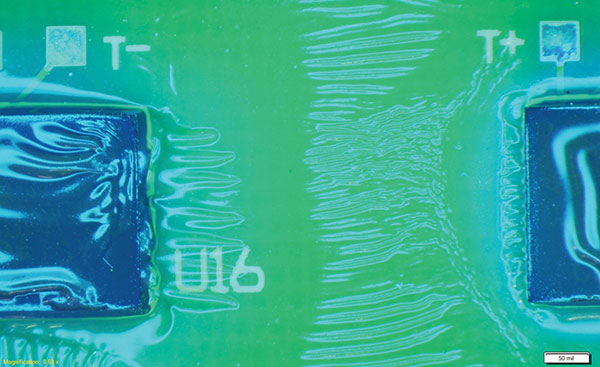Easy Steps to Avoid Silicone Conformal Coating Wrinkling
When it comes to application, less is more.
A common defect our technical support deals with on a regular basis is the wrinkling of high-solids RTV silicone conformal coatings. For those who have struggled with this issue, this column will help you understand why this might be happening and what to do to correct it.
High-solids RTV (room temperature vulcanizing) silicone conformal coatings provide various advantages that help address many PCB design criteria. Some advantages an OEM designer might look for are the ability to withstand extremely high-operating temperatures, good flexibility, and resistance to chemical attack. Fast cure makes these types of silicones attractive for the applicator for high-volume production. However, the fast cure of these silicones also makes them prone to wrinkling and therefore compromises material performance (lower SIR, moisture ingress, etc.), not to mention the less-than-desirable appearance (FIGURE 1). Furthermore, since silicones are tough to rework, stripping the wrinkled coating becomes a challenge due to use and disposal of stripping chemistries.

Figure 1. An example of wrinkling of a silicone conformal coating.
The root cause of wrinkling of the high-solids RTV silicones is a different curing stage between the two sides of coated film. In other words, the applied film surface (top or bottom) is curing at a much faster rate than the opposite side or middle of the coating. The appearance of wrinkles is caused by shrinkage of the cured silicone vs. the as-yet uncured part of the coating.
The four most common mistakes during the application of high-solids RTV silicones are:
- Coating is too thick, causing much longer cure time of the film on the inside than the surface.
- Exposure to very high humidity during the cure cycle, causing unnatural cure acceleration of the surface.
- Coating during extremely hot weather, which causes film to dry (not cure) on the surface.
- Coating of boards with increased level of moisture present on the surface, such as if the boards were brought in from colder storage into a humid room. This would cause the bottom of the coating to cure along with the surface, leaving the middle partially uncured.
Wrinkling corrective actions include:
- Reduce applied film thickness. This thickness will depend on the ambient and curing conditions.
- If a high build coating is required, an additional coating pass may be required rather than single-high thickness.
- Temperature and humidity controls are critical. Standard 65° to 75°F room temperature with relative humidity of 30% to 60% is ideal.
- Make sure boards are dry prior to application.
- Choose a high-solids RTV silicone with low shrinkage to reduce wrinkling susceptibility.
Wrinkling of high-solids RTV silicones is a common defect. The right material and a few simple corrective actions can ensure coating quality is free from these less-desirable attributes.
is key account manager at HumiSeal (humiseal.com); jknop@chasecorp.com.
Press Releases
- Altus Group Expands Aftersales Team to Its Largest Size to Date
- Incap Estonia Invests in New Flying robe System to Advance Production Performance
- Critical Manufacturing Partners with Canonical to Expand Cloud-Native Deployment Options for Manufacturers
- Heller Industries Becomes the Latest Partner to Join THE SMT FUTURE EXPERIENCE







